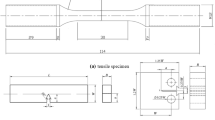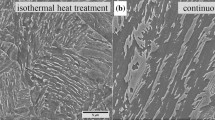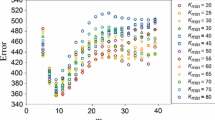Abstract
Fracture behaviour of two different ferritic martensitic grades of steel, namely Indian Reduced Activation Ferritic Martensitic steel and modified 9Cr-1Mo steel (Mod 9Cr-1Mo,P91), are investigated in DBT region using master curve approach. The effects of single and multi temperature methods of master curve and strict censoring, on reference transition temperature are studied. The effect of specimen geometries is studied by comparing CT and TPB geometries. Also the differences in reference transition temperature arising due to the difference in two grades of ferritic martensitic steels are studied.









Similar content being viewed by others
Notes
The number of valid tests for P91 Charpy specimens are 7 for M \(=\) 30.
References
ASTM (2013) E1921 standard test method for determination of reference temperature. T0, for ferritic steels in the transition range
Bhowmik S, Sahoo P, Acharyya S, Chattopadhyay J, Dhar S (2012) Application and comparative study of the master curve methodology for fracture toughness characterization of 20MnMoNi55 steel. Mater Des 39:309–317
Bhowmik S, Sahoo P, Acharyya SK, Dhar S, Chattopadhyay J (2015) Evaluation and effect of loss of constraint on master curve reference temperature of 20MnMoNi55 steel. Eng Fract Mech 136:142–157
Gao X, Dodds RH Jr (2000) Constraint effects on the ductile-to-brittle transition temperature of ferritic steels: a weibull stress model. Int J Fract 102(1):43–69
Joyce J, Tregoning R (2005) Determination of constraint limits for cleavage initiated toughness data. Eng Fract Mech 72(10):1559–1579
Kim BJ, Kasada R, Kimura A, Wakai E, Tanigawa H (2013) Application of master curve method to the evaluation of fracture toughness of F82H steels. J Nucl Mater 442(1):S38–S42
Laha K, Saroja S, Moitra A, Sandhya R, Mathew M, Jayakumar T, Kumar ER (2013) Development of india-specific RAFM steel through optimization of tungsten and tantalum contents for better combination of impact, tensile, low cycle fatigue and creep properties. J Nucl Mater 439(13):41–50
Lucas G, Odette G, Matsui H, Möslang A, Spätig P, Rensman J, Yamamoto T (2007) The role of small specimen test technology in fusion materials development. J Nucl Mater 367(Part B):1549–1556. In: Proceedings of the twelfth international conference on fusion reactor materials (ICFRM-12)
Lucon E, Scibetta M (2011) Application of advanced master curve approaches to the euro fracture toughness data set. In: Fatigue and fracture mechanics: 37th volume. ASTM International
McCabe DE, Merkle JG, Wallin K (2005) An introduction to the development and use of the master curve method. ASTM International, West Conshohocken
Mueller P, Spätig P, Bonadé R, Odette G, Gragg D (2009) Fracture toughness master-curve analysis of the tempered martensitic steel Eurofer97. J Nucl Mater 386:323–327
Nevalainen M, Dodds RH Jr (1996) Numerical investigation of 3-D constraint effects on brittle fracture in SE (B) and C (T) specimens. Int J Fract 74(2):131–161
Paul VT, Saroja S, Albert S, Jayakumar T, Kumar ER (2014) Microstructural characterization of weld joints of 9Cr reduced activation ferritic martensitic steel fabricated by different joining methods. Mater Charact 96:213–224
Sathyanarayanan S, Basu Joysurya, Moitra A, Sasikala G, Singh V (2013) Effect of thermal aging on Ductile–Brittle transition temperature of modified 9Cr 1Mo steel evaluated with reference temperature approach under dynamic loading condition. Metall Mater Trans A 44(5):2141–2155
Tiwari A, Avinash G, Sunil S, Singh R, Ståhle P, Chattopadhyay J, Chakravartty J (2015) Determination of reference transition temperature of in-rafms in ductile brittle transition regime using numerically corrected master curve approach. Eng Fract Mech 142:79–92
Tiwari A, Avinash G, Shokry A, Singh R, Ståhle P (2017) Fracture study of ferritic/martensitic steels using weibull stress analysis at quasi-static and higher loading rates. Int J Fract 205(1):103–109
Wallin K (1999) The master curve method: a new concept for brittle fracture. Int J Mater Prod Technol 14(2–4):342–354
Wallin K, Planman T, Valo M, Rintamaa R (2001) Applicability of miniature size bend specimens to determine the master curve reference temperature T 0. Eng Fract Mech 68(11):1265–1296
Author information
Authors and Affiliations
Corresponding author
Rights and permissions
About this article
Cite this article
Tiwari, A., Singh, R.N. Fracture behaviour of ferritic/martensitic steels in DBT region characterized using CT and TPB specimen geometries. Int J Fract 209, 241–249 (2018). https://doi.org/10.1007/s10704-017-0250-y
Received:
Accepted:
Published:
Issue Date:
DOI: https://doi.org/10.1007/s10704-017-0250-y




